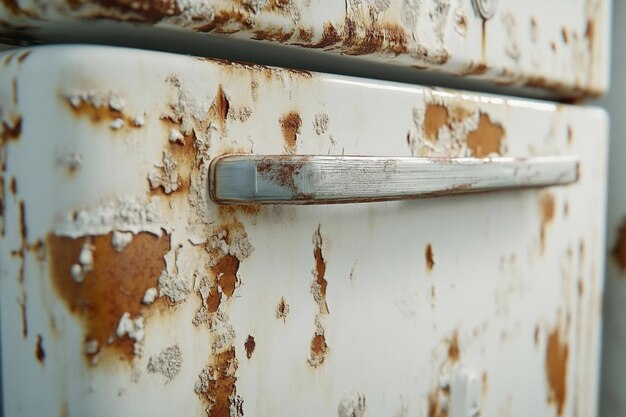Say Goodbye to Rust: Your Guide to Removing Rust Spots from Your Refrigerator
Imagine walking into your kitchen, your eyes landing on the shiny centerpiece of your home—the refrigerator. But as you approach it, your gaze falls upon unsightly rust spots, tarnishing its once-pristine appearance. Rust not only affects aesthetics but can also compromise the appliance's functionality over time. Fear not, for there are effective ways to combat this rusty adversary. In this article, we'll explore how to restore your refrigerator to its former glory by effectively removing rust spots and preventing them from making a reappearance.
Understanding the Enemy: What Causes Rust on Refrigerators?
Before diving into removal methods, it's essential to understand what causes rust on refrigerators. Rusting is a chemical process that occurs when iron reacts with oxygen in the presence of moisture, forming iron oxide—commonly known as rust. Here's why refrigerators are prone to rust:
Humidity and Moisture: Kitchens are often hotbeds of humidity, especially when cooking or during humid seasons. This elevated moisture level can speed up the rusting process.
Scratches and Damages: Daily wear and tear can lead to small scratches or dents, compromising the protective coating of the refrigerator and giving moisture a way in.
Geographical Location: Those living near the coast or in regions with high humidity levels might notice rust appearing faster due to the salt content and moisture in the air.
🛠️ Common Areas Affected
Rust isn't discriminatory—it can appear in various spots on your refrigerator. Some common areas include:
- The exterior surface
- Door hinges and handles
- Base edges where moisture can accumulate
Step-By-Step Guide to Removing Rust Spots
Let's get into the nitty-gritty of removing rust spots. Here’s a step-by-step guide that empowers you to tackle rust effectively.
🧹 Preparation: What You Need
Before starting, gather the following materials:
- Fine sandpaper or a sanding block: For gently scrubbing off rust.
- Baking soda and water paste: Natural and gentle abrasive.
- White vinegar: An effective rust removal agent.
- Soft cloths: For cleaning and drying.
- Rust-resistant paint (optional): For repainting any areas post-removal to prevent future rusting.
⚙️ Removal Process
Unplug the Fridge: Always prioritize safety. Disconnect your fridge from power before starting any work.
Clean the Area: Use a damp cloth to wipe down the rusty sections, removing any dirt or dust particles.
Use Sandpaper: Gently rub the sandpaper over the rust spots. The key here is gentle force—scrub just enough to remove the rust without damaging the metal beneath.
Apply Baking Soda Paste: If the rust persists, apply a paste made of baking soda and water to the affected area. Let it sit for an hour before scrubbing it gently with a cloth.
Vinegar Treatment: Dampen a cloth with white vinegar and dab it onto the rust spots. Allow it to sit for 30 minutes. The acidity in vinegar can effectively break down rust.
Final Wipe Down: Use a clean, dry cloth to wipe away any residues.
Consider Painting: If the rust has left the area discolored, you might want to apply a rust-resistant paint once the area is fully dry.
🔧 Pro Tips
- Multiple Treatments: Severe rust spots may require multiple treatments to be fully removed.
- Avoid Excess Water: When cleaning, ensure no water is left pooling around the base of the fridge.
Preventing Rust from Making a Comeback
Once you've rid your fridge of rust, the goal is to keep it that way. Here are some tips to prevent rust from forming in the future:
🌬️ Control Humidity
Invest in a dehumidifier for the kitchen, especially if you live in a high-humidity area. This can significantly reduce moisture that leads to rust.
🔍 Routine Maintenance
Regular checks for scratches and chipping paint can prevent rust before it starts. Apply touch-up paint to minor scratches to seal and protect the surface.
🚫 Avoid Harsh Cleaners
Steer clear of abrasive cleaning agents that can strip away protective coatings. Opt for gentle cleaning solutions instead.
🏠 Kitchen Environment
Ensure good ventilation within your kitchen. This reduces humidity and prevents moisture from settling on your appliances.
🤔 Frequently Asked Questions
❓ Can I use commercial rust removers?
Yes, commercial rust removers can be effective. However, always follow product instructions and test on a small area first to ensure it doesn’t damage the fridge.
❓ Are there any precautions when using vinegar or baking soda?
Both are relatively safe cleaning agents, but it's advisable to test them on a small area beforehand to ensure no unwanted reactions occur.
❓ Should I consult a professional for extensive rust damage?
For extensive rust, particularly in critical areas like hinges or internal components, consult a professional to avoid compromising the refrigerator's functionality.
📜 Quick Recap: Key Takeaways for Rust-Free Refrigerators
Here’s a quick summary to keep your refrigerator looking like new:
- Eliminate rust with a combination of mechanical and natural cleaning methods.
- Prevent future rusting by controlling humidity and routinely inspecting the appliance.
- Opt for soft cleaning agents to maintain the fridge’s protective coatings.
Closing Thoughts: A Stainless Future
Keeping your refrigerator in pristine condition is a testament to household care. With these strategies at your disposal, those rust spots stand no chance. Embrace the simplicity and effectiveness of natural cleaning solutions combined with routine maintenance to ensure your appliance continues to shine in the heart of your home for years to come.
Remember, while tackling rust doesn't require a professional certification, it does call for diligence and care. Be precise, be gentle, and above all, be consistent.
Now, with rust out of the way, you can focus on what truly matters—keeping those delicious ingredients fresh and your kitchen looking stellar. Happy cleaning!
